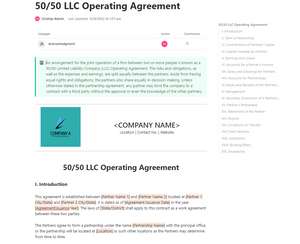When it comes to starting a business, entrepreneurs often consider the option of partnering with someone to share the responsibilities and risks. A 50/50 business partnership is a common arrangement, but what exactly does it entail? In this article-How Does a 50 50 Business Partnership Work, we’ll explore the ins and outs of a 50 50 partnership, from its definition and benefits to potential challenges and tips for making it work.
What is a 50/50 Partnership in Business?

In a 50/50 partnership, two individuals or entities each own 50% of the business and share equal decision-making power, responsibilities, and profits or losses. This type of arrangement is often chosen because it allows for a fair and equal division of the business’s management and financial aspects. However, it’s important to note that a partnership doesn’t have to be 50/50 to be successful.
What Makes Partnership Working Effective?

A successful business partnership relies on several key factors:
- Trust and mutual respect: Partners must trust each other’s judgment and respect their expertise and contributions.
- Clear communication: Open and honest communication is essential to avoid misunderstandings and ensure smooth collaboration.
- Defined roles and responsibilities: Clearly outlining each partner’s duties and responsibilities can help avoid conflicts and confusion.
- Shared vision and goals: Partners should have a common understanding of the business’s direction and objectives.
- Conflict resolution: Developing strategies for resolving disagreements is crucial to maintaining a healthy partnership.
How Does a 50/50 Partnership Work?

A 50/50 partnership can be structured in various ways, such as through a general partnership or a limited liability company (LLC). Regardless of the legal structure, there are several key elements to consider in a 50/50 partnership:
Decision-Making
In a 50/50 partnership, both partners have an equal say in decision-making. However, it’s important to establish a clear process for making decisions to avoid deadlocks or disputes. This can include majority rule, consensus, or a designated tie-breaker.
Profit and Loss Sharing

In a 50/50 partnership, profits and losses are typically split evenly between the partners. This means that each partner is responsible for 50% of the business’s financial success or failure.
Responsibilities and Duties
Both partners should clearly define their roles and responsibilities in a 50/50 partnership. This can help prevent misunderstandings and ensure that both partners are contributing equally to the business.
Ownership Structure
A 50/50 partnership can be structured as a general partnership, where both partners share unlimited liability, or as an LLC with 50/50 ownership, where both partners have limited liability protection.
Does a Partnership Have to be 50/50?
While a 50/50 partnership is a popular choice, a partnership doesn’t have to be structured this way. Partnerships can have unequal ownership stakes, such as a 60/40 partnership, and still function effectively as long as the partners agree on the terms and expectations.
Is a 50/50 Partnership a Good Idea?
Whether a 50/50 partnership is a good idea depends on the specific circumstances and the individuals involved. Here are some potential advantages and disadvantages:
Pros:
Equal division of responsibility, decision-making power, and profits/losses.
- Partners can complement each other’s strengths and weaknesses.
- Shared risk can lead to more cautious and thoughtful decision-making.
Cons:
- Potential for deadlocks in decision-making.
- Disagreements may arise if one partner feels they are contributing more than the other.
- The success of the partnership is heavily reliant on the relationship between the partners.
Considering these pros and cons, a 50/50 partnership may be a good idea if both partners have a strong working relationship, share a common vision, and have clearly defined roles and responsibilities.
How to Split a Business 50/50
To create a 50/50 partnership, follow these steps:
- Draft a partnership agreement: This document should outline the terms of the partnership, including ownership percentages, decision-making processes, and profit/loss sharing.
- Define roles and responsibilities: Clearly delineate each partner’s duties within the business.
- Establish a decision-making process: Agree on a method for making decisions, such as majority rule or consensus.
- Set up a system for tracking financial contributions and distributions: This can help ensure that profits and losses are split fairly between partners.
- Develop a plan for resolving conflicts: Having a pre-determined strategy can help keep the partnership on track during challenging times.
How Does a 60/40 Partnership Work?
A 60/40 partnership is similar to a 50/50 partnership but with unequal ownership stakes. In this arrangement, one partner owns 60% of the business, while the other owns 40%. Decision-making power, profits, and losses are typically divided according to ownership percentages, although partners can agree on alternative arrangements.
How to Make a 50/50 Partnership Work
To make a 50/50 partnership work, consider the following tips:
- Build a strong foundation: Establish trust and mutual respect by getting to know your partner’s strengths, weaknesses, and work style.
- Communicate openly and honestly: Regularly discuss business progress, concerns, and expectations.
- Establish boundaries: Clearly define the roles and responsibilities of each partner and avoid micromanaging each other’s work.
- Stay flexible: Be willing to adapt and change as the business grows and evolves.
- Celebrate successes together: Acknowledge each other’s contributions and celebrate milestones as a team.
Can an LLC be 50/50?

Yes, an LLC can be structured as a 50/50 partnership, with each partner owning 50% of the company and sharing equal decision-making power and financial responsibilities. This arrangement combines the benefits of a partnership with the limited liability protection offered by an LLC.
How to Dissolve a 50/50 Business Partnership

If a 50/50 partnership is no longer viable, partners may choose to dissolve the partnership by following these steps:
- Review the partnership agreement: Consult the partnership agreement for guidance on dissolution procedures.
- Notify creditors and suppliers: Inform all relevant parties of the dissolution.
- Settle outstanding debts: Pay off any remaining business debts, either by liquidating assets or with personal funds.
- Distribute remaining assets: Divide any remaining assets between the partners according to the partnership agreement.
- File dissolution paperwork: Complete and submit any necessary paperwork to legally dissolve the partnership.
In conclusion, a 50/50 business partnership can be a successful and rewarding arrangement, provided both partners have a strong working relationship, clear communication, and well-defined roles and responsibilities. By carefully considering the advantages and disadvantages.
